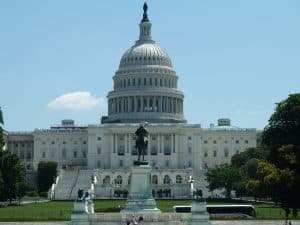Can Federal Grants Drive Personalized Learning?
CompetencyWorks Blog
 This post originally appeared at the Christensen Institute on February 13, 2015.
This post originally appeared at the Christensen Institute on February 13, 2015.
As ESEA debates heat up on the Hill this month, in addition to reconsidering the federal role in school accountability, there has been a growing discussion about whether and how the federal government should fund innovation in education. There are a variety of programs under consideration that could make this happen.
For example, earlier this week, Representative Jared Polis (D-CO) re-introduced the Investing in Innovation in Education Act, which would award money for classroom technology investments, among other things. And Senators Orrin Hatch (R-UT) and Marco Rubio (R-FL) are floating the 21st Century Classroom Innovation Act, which calls for the government to carve out supports for school systems that are blending face-to-face and online instruction.
Although federal innovation grants are not new to the education field, they could be a potent driver of moving personalized learning forward. What are the potential benefits of a federal innovation agenda and where would these dollars be best spent? Here are three areas to consider:
First, subsidizing switching costs to move toward blended learning—and studying those costs and benefits. We are frequently asked, “How much does it cost to implement blended learning?” But it’s difficult for us to give a clear estimate because schools incur widely varying costs when going blended depending on their circumstances, infrastructure, or other factors. What we do know, however, is that schools have limited access to funds to make that transition. The federal government can start to fill this gap by creating programs that support blended learning. A rigorous grant application process could also unearth helpful data on how school systems are estimating their own switching costs, where they are or are not looking for grant money, and how they are breaking down one-time versus ongoing expenses—this is data that currently is ill-defined and rarely studied in depth.
Second, seeding local examples and proof points of blended, competency-based schools. A lot of the details of policy and funding streams that could move us to more personalized-learning models must get worked out at the state level. But there’s a bit of a chicken-and-egg dilemma happening right now in the states: policymakers are being asked to legislate in support of models that by and large don’t exist yet. And few states are shelling out substantial funds to subsidize the switching costs described above. Awarding federal grants to local school systems that are pursuing blended- and personalized-learning models could exert pressure on state policymakers by showing—concretely—what personalized approaches could look like in their states when brokered by local educators and leaders whom they know and trust. Without sufficient funding to create homegrown proof points, I worry that state policymakers might miss the mark in trying to support personalized-learning models. With innovation investments in support of schools transitioning to blended- and personalized-learning approaches, the federal government could fill this gap in proof points without forcing a particular policy agenda upon the states.
Third, doubling down on R&D. Currently, some of the most exciting R&D in personalized learning is happening within the education technology companies that are creating tools and products for schools. We need more robust political and financial support, however, for education research across states and schools that are deploying different models and tools, as well as serving a variety of students. Grants to fund innovation could provide a rich sample of school systems to study, and the government could set parameters that would allow for more robust comparisons across these school systems. There is already valuable information about the successes and challenges of personalized-learning implementation that is coming out of Race to the Top District Grants—for example, Education Week produced a great set of grantee report cards and the Department of Education commissioned a number of case studies describing the activities afoot in some districts.
Still, a key research question in personalized learning remains unanswered—to really take personalized learning to scale, we need to begin by answering the question of what approaches work best for what students in what circumstances. The federal government, as a funder of innovation and one of the biggest investors in research more broadly, can position itself to lead the way in answering that question, in part borrowing from the experiments and experiences among its grantees.
With an eye towards these three areas, the federal government may successfully fill real gaps in the personalized learning landscape, while leaving room for experimentation at the state and local level.
Julia researches innovative policies and practices in K-12 education, with a focus on competency based education policies, blended learning models, and initiatives to increase students’ social capital.